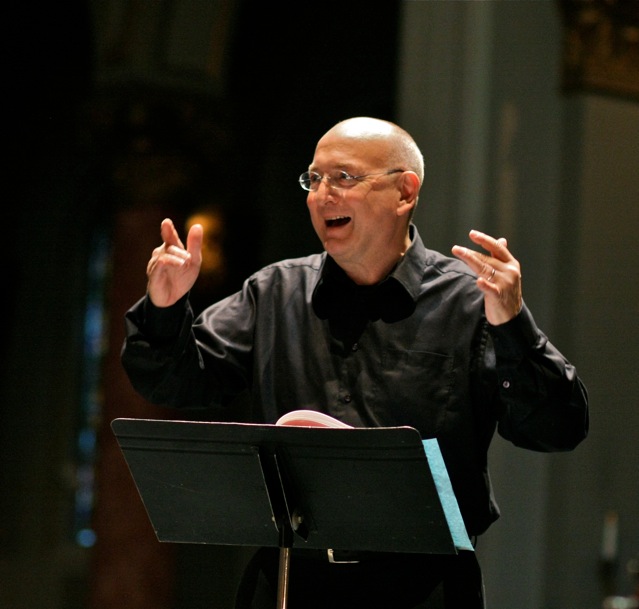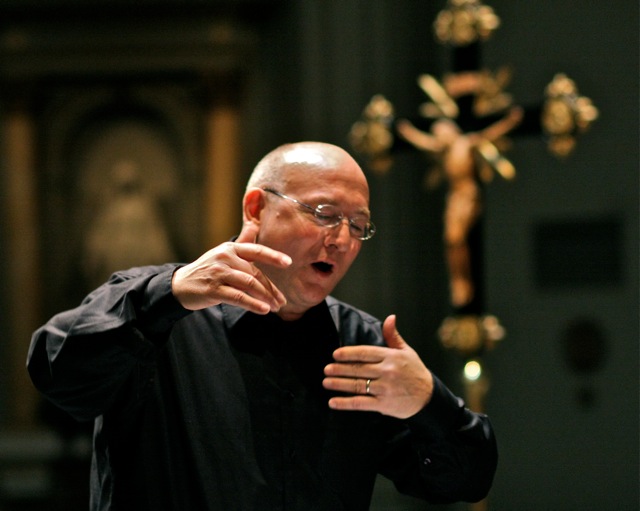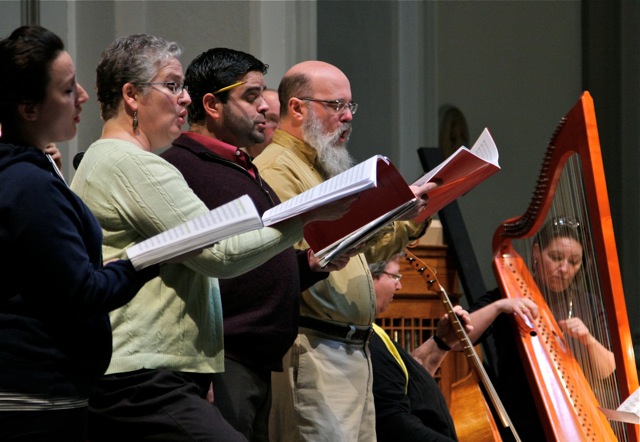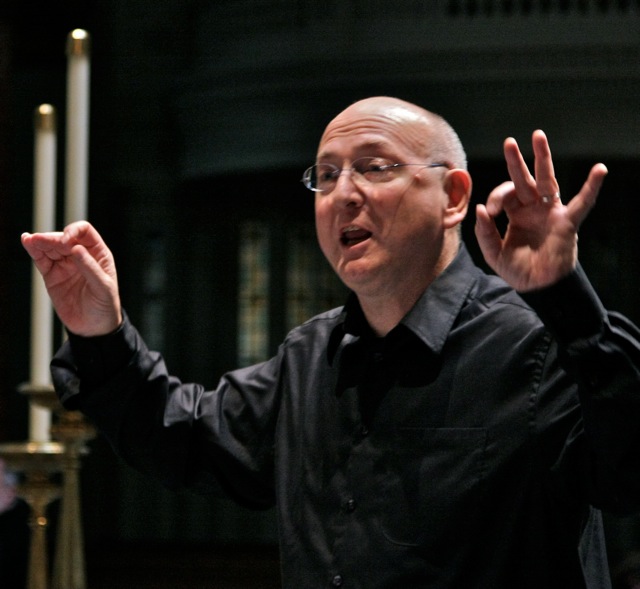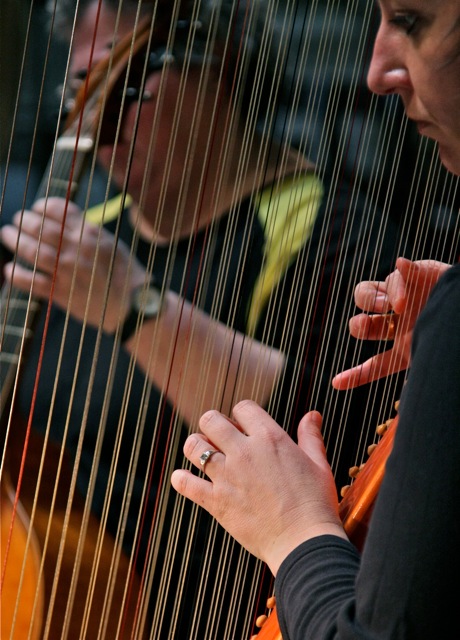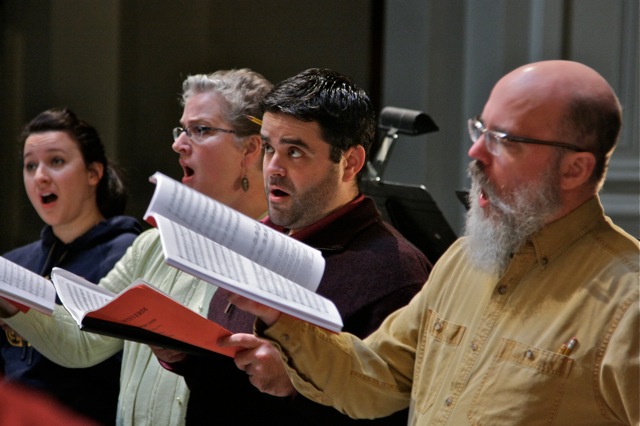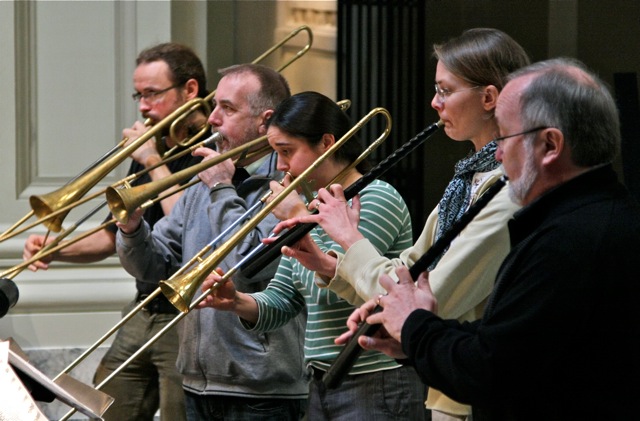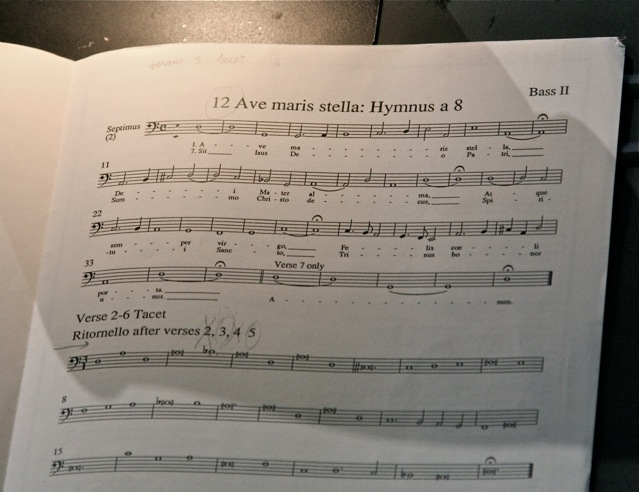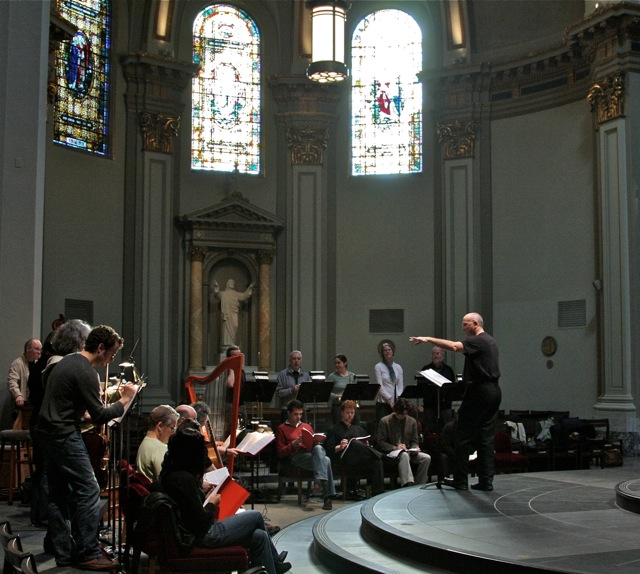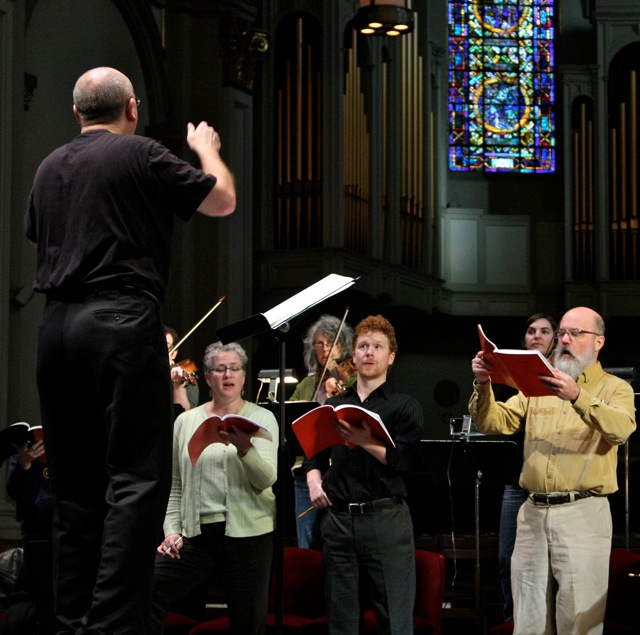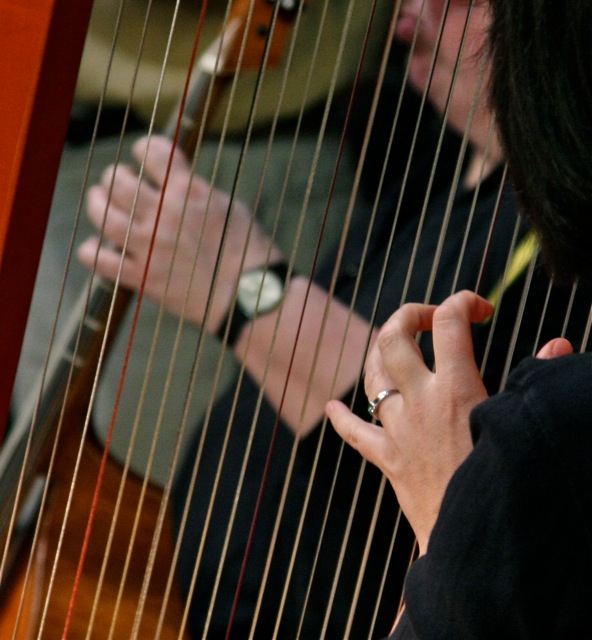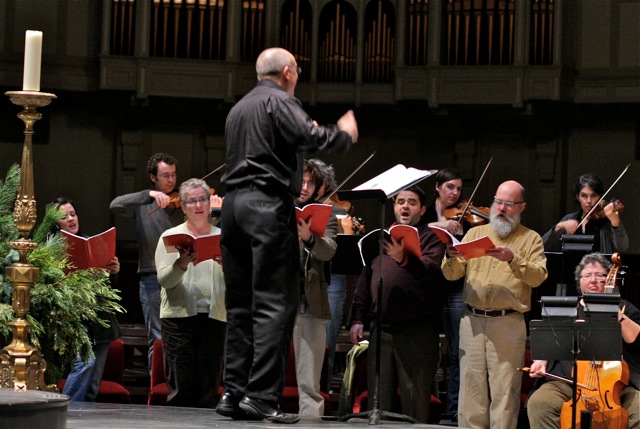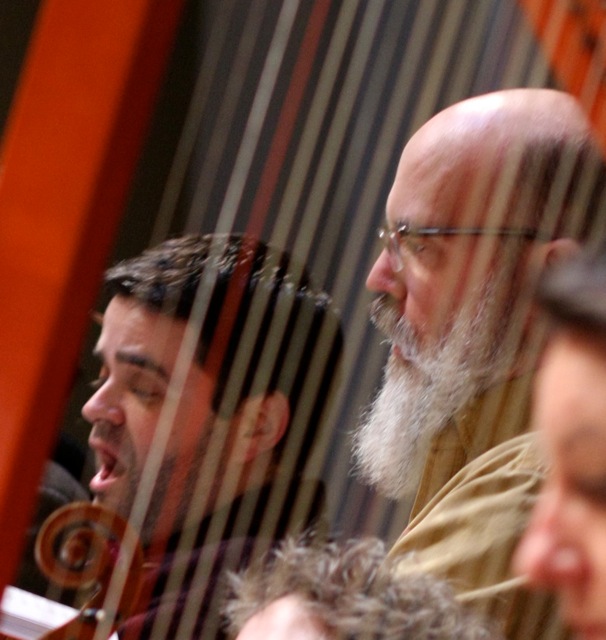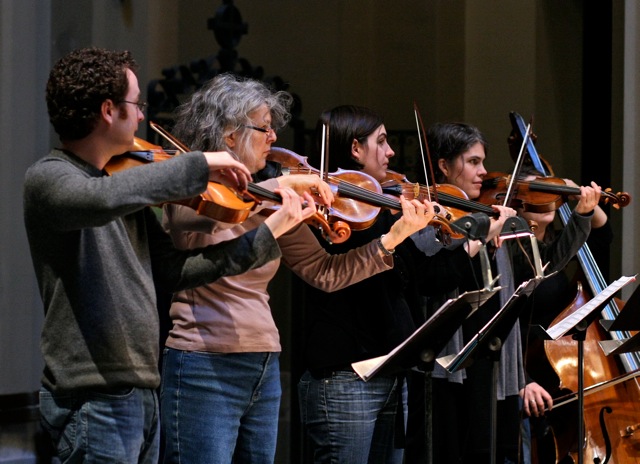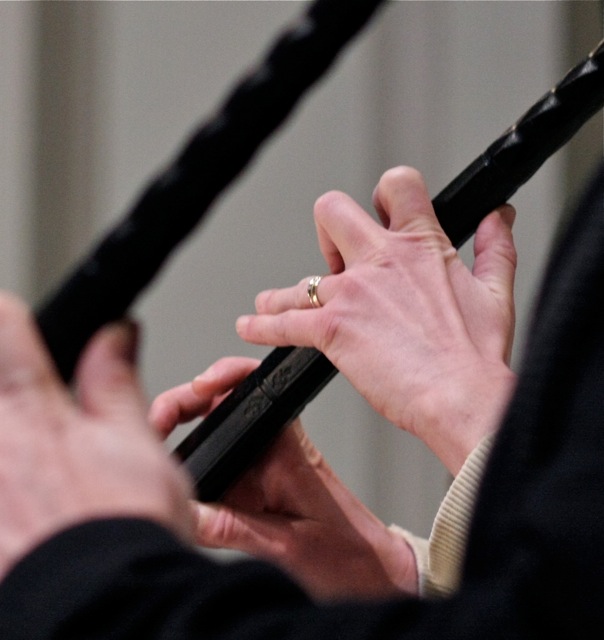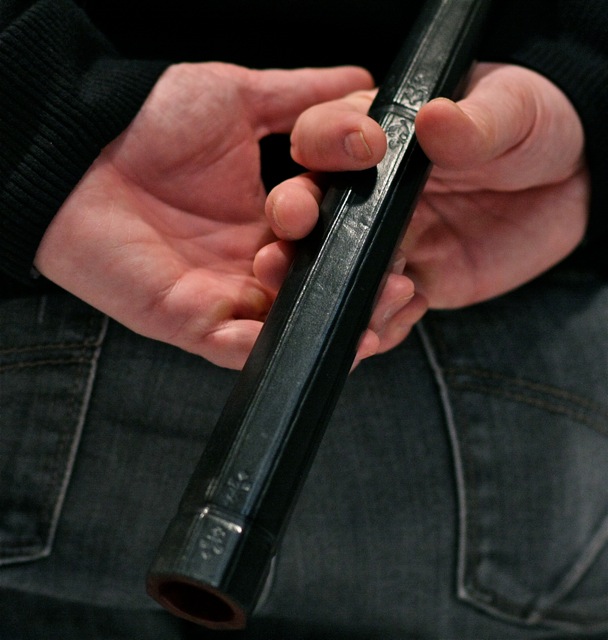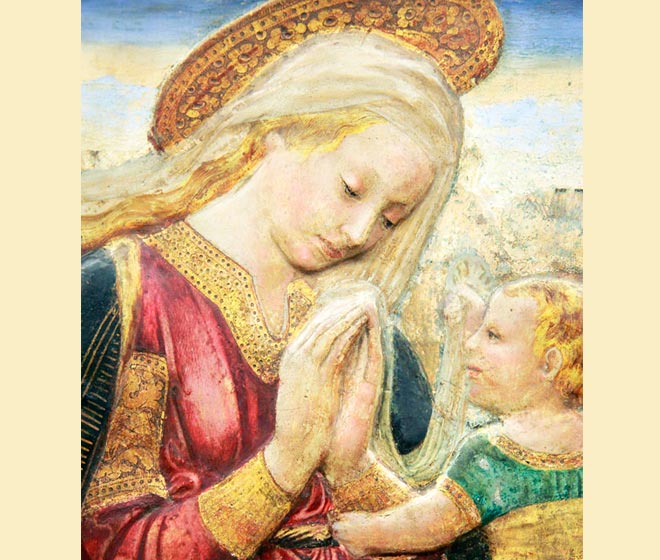Canticum Canticorum-Ecstatic Surrender
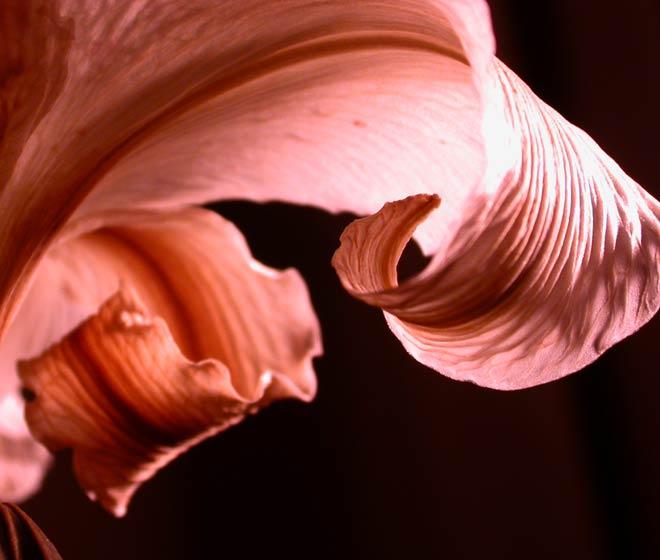
“The Song of Songs is a cry of erotic longing and a description of erotic bliss. It is a lyrical drama whose speakers and episodes run into each other as in a dream or a vision….It is a canonical biblical text, and yet there is no mention of God or of religion. It haunts many cultures, eastern and western.”
Over the course of the centuries, there have been innumerable exegeses, imitations, and paraphrases of the Song of Songs, and not just from religious authors; its poetic and amorous scenes have influenced numerous writers of all kinds. Many fragments of this beautiful text have been set to music. Taking advantage of its sensual and imagistic richness, composers have, as Lino Bianchi wrote of Palestrina, “been able to capture in the heart of sound the transcendent emotions of the most arcane theology.” In this sensual and textured program Les Voix Baroques offer some of the most expressive of these settings.
Adapted from A.S. Byatt
Musical Direction: Stephen Stubbs
Vocal Soloists of Les Voix Baroques: Shannon Mercer, Catherine Webster, Meg Bragle, Jacques Olivier Chartier, Sumner Thompson, Douglas Williams,
Musicians from the Pacific MusicWorks Baroque Orchestra:
Tekla Cunningham, Emma McGrath, Laurie Wells, Margaret Little, Maxine Eilander, Joseph Adam
Venue: Daniels Recital Hall, Seattle
Date and Time: Oct 22, 8:00pm, 2011
Ticket Prices: 35$ General/20$ Students
Parking: Off street parking available for $7.50 at the Bank of America Garage: 800 5th Avenue- Entrance is on Columbia
Handicap accessible.
JOIN ARTISTIC DIRECTOR STEPHEN STUBBS AND EXECUTIVE DIRECTOR MATTHEW WHITE FOR A PRE-CONCERT TALK ABOUT THE REPERTOIRE AT 7:00PM IN DANIELS HALL!
TO BUY TICKETS TO THIS EVENT CLICK HERE
October 22, 2011 - 8:00pm - 10:00pm
Location
Handel’s Oratorio Esther (The 1720 version)
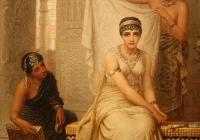
Pacific Musicworks, St.James Cathedral and the Tudor Choir, conducted by Stephen Stubbs, present what is regarded as Handel’s first English Oratorio as part of the American Handel Festival.
Soloists Include: Shannon Mercer, Catherine Webster, Matthew White, Ross Hauck, Zachary Wilder, Charles Roberts Stephens,
Though this is Handel’s first oratorio, it already demonstrates Handel’s ability to create an enormous variety of color and to bring to life compelling drama in music. The story begins with the Israelites in a joyful mood as they have just learned that their queen Esther has been made Queen by the Persian King Ahasuerus. This joy quickly turns to sadness when they hear that the King’s High Priest Haman has ordered the death of all Jewish people in the kingdom. Esther’s kinsman, Mordechai, begs the new Queen to use her influence with the King to save the Jewish people from Haman’s evil decree. Through the use of her considerable charms, and some help from Handel’s bewitching music, Esther is successful and Haman is sentenced to death. The Oratorio ends as joyously as it began with the Jewish people celebrating their victory.
Venue:?St. James Catholic Cathedral, Seattle, WA 98104
Date and time: March 26, 2011 8 pm concert
Passes $40 General/$25 Students; brownpapertickets.com; (800) 838-3006
Date: March 26, 2011 - 8:00pm
BEMF’s Acis and Galatea by G.F.Handel
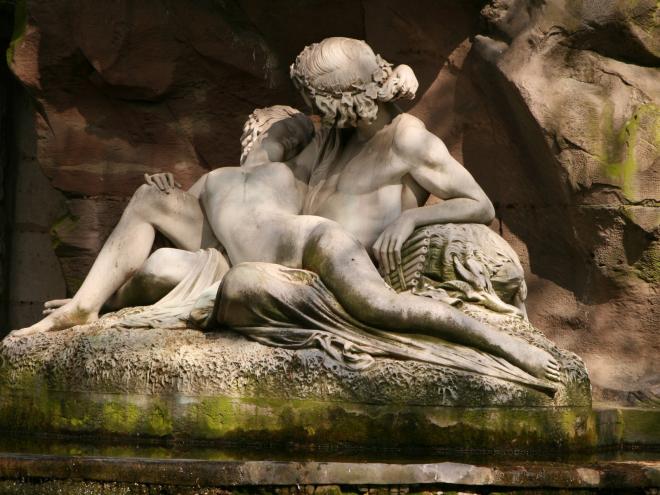
Proclaimed “the highlight of local opera presentations,” the Boston Early Music Festival’s stunning period productions of Baroque operas have become a must-see event for opera lovers from around the world. Pacific Musicworks presents BEMF’s production of the original 1718 chamber version of Handel’s beloved pastoral opera Acis and Galatea, led by musical directors Paul O’Dette and Stephen Stubbs, stage director Gilbert Blin, and costume designer Anna Watkins.
The story depicts the love affair between the nymph Galatea and the shepherd Acis, who must endure a long separation. When they are finally reunited, their happiness is dashed by the jealous monster Polyphemus, who is in love with Galatea and kills Acis. As Galatea laments the loss of her lover, she uses her divine powers to transform Acis into an everlasting fountain.
Tenor Aaron Sheehan and soprano Teresa Wakim will appear in the title roles, accompanied by the three-time Grammy-nominated Boston Early Music Festival Chamber Ensemble.
Fully staged Boston Early Music production presented by Pacific Musicworks as part of the American Handel Festival.
Venue: Town Hall,
Dates and time: March 25, 2011 8pm concert
Tickets: $50 General Admission/$25 Students;
Brownpapertickets.com (800) 838-3006
** PREMIUM 90$ tickets are only available through the American Handel Festival (206)-999-7045
PARKING INFORMATION FOR TOWN HALL
Paul O’Dette & Stephen Stubbs, Musical Directors, Gilbert Blin, Stage Director?Anna Watkins, Costume Designer, Robert Mealy, Orchestra Leader?Kathleen Fay, Executive Producer?Darren Brannon, Associate Producer?Melinda Sullivan, Assistant to the Stage Director
Aaron Sheehan, Acis
Teresa Wakim, Galatea*
Jason McStoots, Damon
Douglas Williams, Polyphemus
Zachary Wilder, Coridon
SEE A VIDEO OF THIS PRODUCTION:
the American Handel Festival page
March 25, 2011 - 8:00pm
1610 Vespers by Claudio Monteverdi
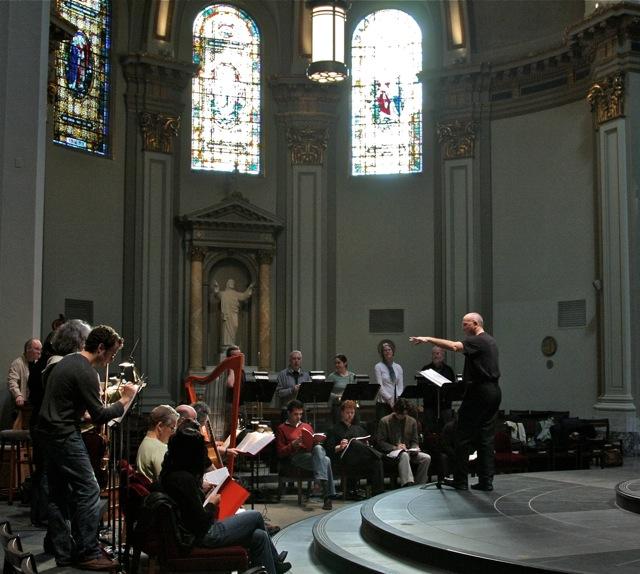
A concert version of Claudio Monteverdi’s masterpiece.
Photos by Lee Talner
December 3, 2010 - 8:00pm - December 4, 2010 - 8:00pm
Location
Heiner Goebbels: Songs of War I Have Seen & Monteverdi: Il Combattimento di Tancredi e Clorinda
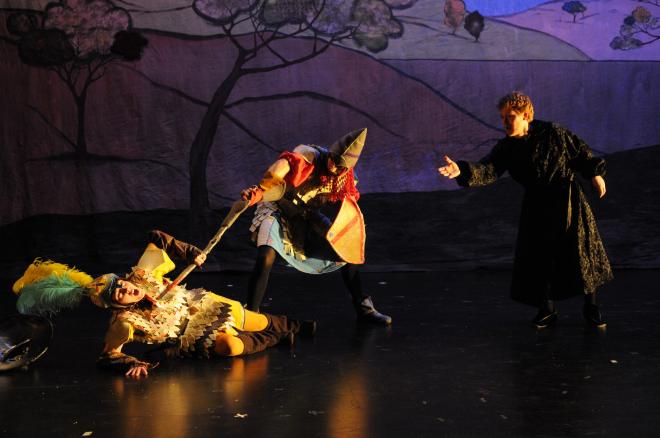
Heiner Goebbels: Songs of War I Have Seen, conducted by Anu Tali
Monteverdi: Il Combattimento di Tancredi e Clorinda (2009), conducted by Stephen Stubbs
This collaboration with Seattle’s premier new music ensemble, Seattle Chamber Players, began with the idea to bring Heiner Goebbels to Seattle to recreate his major music-theater piece called Songs of Wars I Have Seen, composed for the re-opening of London’s Southbank in 2003. In the Seattle context the partnership of Pacific Musicworks and Seattle Chamber Players will allow us to recreate the fascinating combination of modern and baroque instruments with wartime text fragments of Gertrude Stein. On the Boards, the third partner, is exactly the right Seattle venue to create a meeting place for followers of new music and early music, as well as those interested in the latest developments in theater and the visual arts. To form a double-bill with Songs, Pacific Musicworks has created a new staging of Monteverdi’s Il Combattimento di Tancredi et Clorinda.
Monteverdi’s Combattimento from 1624 belongs to the first generation of operatic masterpieces and broke new ground in a number of ways including the innovative use of new string techniques, and a new level of emotional intensity. The text, from Tasso’s Gerusalemme Liberata, tells the story of Tancredi the Christian Soldier in love with the Saracen maid Clorinda. When they meet on a dark battlefield by night he takes her to be an enemy combatant. They fight to the death, Tancredi wins, then discovers the appalling truth just before Clorinda dies in his arms. The dual themes of war and its effects on women make the pairing with Songs a meeting of minds and artistic visions across four centuries between Monteverdi and Goebbels. It also offers a creative opportunity for choreographer Anna Mansbridge and artist Claire Cowie to re-imagine the timeless story for our time.
Photos by Bill Mohn
The Return Of Ulysses
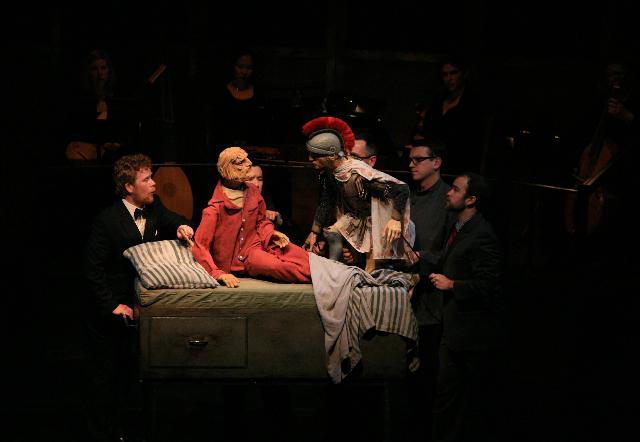
By Claudio Monteverdi
Production directed by William Kentridge
Revival of production directed by Luc De Wit
Musical direction by Stephen Stubbs
Featuring the Handspring Puppet Company of South Africa
A superb tale is always worth the retelling. A story from the bedrock of our culture, Homer’s Odyssey, was brought to vivid life again by Claudio Monteverdi in Venice in 1640, focusing the action on Ulysses’ return to Ithaca after his “Odyssey” of more than 20 years. Aided by the goddess Minerva and disguised as an old beggar, he reveals his true identity and power as he routs the unwelcome suitors who have plundered his home and wooed his long-suffering wife, Penelope.
Monteverdi’s masterful wedding of words with music of unique expessive exactness gave birth to one of the seminal masterpieces of opera. Now, South African artist William Kentridge recreates the story for our time: placing the dying Ulysses in a hospital ward in modern Johannesburg, and using his inimitable video graphics and life-sized puppets to add a fascinating visual world to Homer’s epic and Monteverdi’s music, he brings us into direct contact with the power of myth.
Performed in Italian with English subtitles.
Mozart’s The Magic Flute
Mozart’s The Magic Flute
7:30pm May 8 & 9, 2015 2:00pm May 10, 2015
a collaboration with UW School of Music.
Tickets: $65
Seniors: $40
Under 25: $25
Children 7 - 12 free with accompanying ticketed adult
One of Mozart’s crowning achievements, the Magic Flute is a potent alchemical mixture of popular music and theater with a depth of meaning that is still mysterious and controversial. The fact that Mozart had steeped himself in the music of Handel and Bach in the years leading up to Magic Flute makes it also a personal testament to his admiration for their art. Our production will combine an entirely new staging conception by stage director Dan Wallace Miller, with new dialogue by Karen Hartman, and with one of the reigning “Queen’s of the Night” in our time, Cyndia Sieden.
Hear GRAMMY winner Stephen Stubbs conduct Mozart’s beloved opera in Seattle’s first historically informed performance with a classical orchestra.
Sung in German with English supertitles. World premiere of new spoken dialogue in English by Karen Hartman.
Cast in order of appearance:
Tamino Ross Hauck
Papageno Geoffrey Penar
Pamina Mary Feminear
The Queen of the Night Cyndia Sieden
Papagena Emma Grimsley
Sarastro Colin Ramsey
First lady Holly Boaz
Second Lady Celeste Godin
Third Lady Julia Benzinger
Monostatos Alasdair Elliott
Speaker of the temple Matthew Scollin
Three Spirits Denna Good-Mojab, Michelle Bretl, Margaret Boeckman
Tenor Priest Pablo Piantino
Bass Priest Patrick Borror
Buy Tickets Here or call 206 543 4880
The Story:
Act 1
Tamino, a wealthy young prince in the bad part of town, is pursued by danger and rendered unconscious. Three Ladies, servants of Lady Starfire, the Queen of the Night, save him. They fawn over him, realizing he might be the solution to their Queen’s troubles. They run off to inform their Lady as Tamino awakens in the presence of Papageno, an eccentric local who collects birds for Lady Starfire. Tamino assumes Papageno saved him from danger, and Papageno happily takes credit. The Ladies reappear and gag Papageno so he cannot talk. They show Tamino a picture of Pamina, the Queen’s daughter, and he is immediately smitten. The Queen herself appears to Tamino and explains that her daughter has been kidnapped by the evil Sarastro, and that Tamino is her only hope of rescue. The Ladies give Papageno magic bells, allow him to speak again, and send him along with Tamino, to whom they give a magic flute.
Papageno becomes separated from Tamino and sees Pamina fleeing from the besotted Monostatos, a servant of Lord Sarastro. In the darkness, Monostatos mistakes Papageno for a hulking monster and flees. Papageno recognizes Pamina and tells her of Tamino’s love and noble rescue effort. Thus befriended, they leave together in search of Tamino.
Tamino is led by three helpful Spirits to the entrance of Sarastro’s domain. They tell him that in order to achieve victory in his task, he must become a man. Tamino attempts to gain entry into Sarastro’s domain, but is repelled by unseen voices. He is greeted by Sarastro’s Speaker, who questions his intentions. The Speaker informs him that he has been deceived and that the true evil is not Sarastro, but Lady Starfire. Tamino, dejected, plays his magic flute.
In the distance, Papageno and Pamina hear Tamino, who rushes off to find them. Papageno and Pamina are intercepted by Monostatos and his bevvy of minions, who threaten to enslave the both of them. Papageno plays his magic bells. The charmed music drives off the villains, and they then find themselves in front of Sarastro. Pamina admits to Sarastro that she attempted escape, and Sarastro forgives her, saying that while she is not yet free, forcing Monostatos’ love upon her was wrong. Monostatos enters with Tamino in tow, and Sarastro congratulates him for catching the intruder before sending him off to be lashed. Sarastro orders Tamino be purified.
Act 2
Sarasto explains to his Company of followers that Tamino and Papageno must undergo the Trials in order to be taken into the Company. Pamina says her goodbyes to Tamino, who embarks on a dangerous journey that could lead to death. Papageno and Tamino are led to a chamber. A Priest tells Papageno that if he succeeds in his trials, Sarastro has the perfect mate for him: Papagena. The Priests tell the men that they must undergo a vow of silence and not speak, even to their intended loves. The Queen’s three ladies appear and try to talk sense into Papageno and Tamino, but are ignored.
Meanwhile, Monostatos lustfully sneaks into Pamina’s sleeping chamber, enraged with envy and self-loathing. The Queen appears and drives Monostatos off. She presents her daughter with a knife and commands her to murder Sarastro. Monostatos overhears and threatens to tell Sarastro of Pamina’s plans unless she submits to him. Sarastro enters and casts Monostatos out of his domain. Sarastro explains to Pamina that vengeance has no place in his kingdom.
The three Spirits come to Papageno and Tamino and give the men their magical instruments, which were taken by Sarastro. Pamina enters and is overjoyed to find Tamino, who, following the Priests’ commands, ignores her. Dejected and unloved, Pamina runs off. Papageno, out of boredom, plays his magic bells and muses about how much he’d like a girlfriend. A grotesque creature appears and tells Papageno that she is destined for him. He is incredulous, and she transforms into Papagena before disappearing.
Pamina, wracked with sorrow, attempts to kill herself with her mother’s knife. The three Spirits stop her and bring her to Tamino, who is undergoing the Trials.
Papageno, having blown it with Papagena, attempts suicide. The three Spirits stop him and tell him to play his magic bells. The bells make Papagena appear and the two gleefully embrace, with plans on spawning many little Papagenos.
With her and the magic flute’s help, Tamino and Pamina survive the trials. Monostatos leads the Queen of the Night and her three Ladies into Sarastro’s domain, where Sarastro captures them. The Company rejoices.
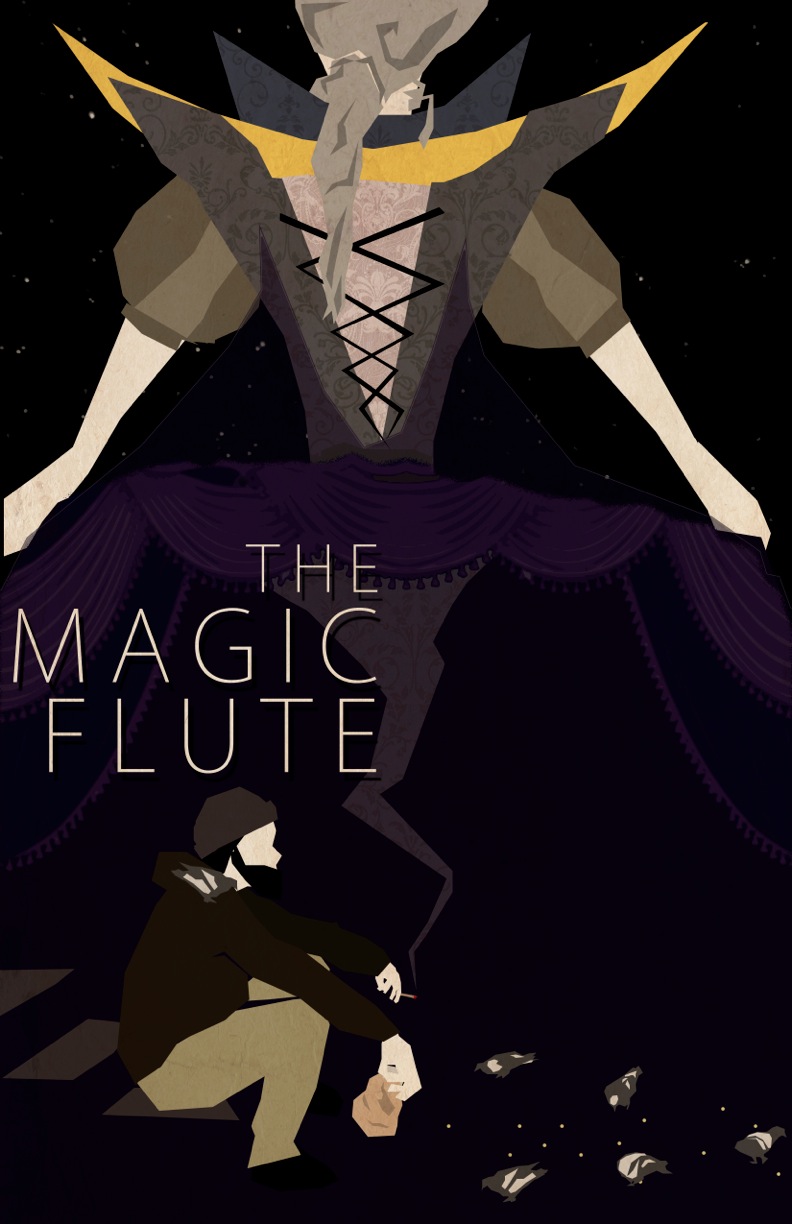
An American Tune
An American Tune
8pm March 21, 2015
Nordstrom Recital Hall
at 7pm Stephen Stubbs will conduct a pre-concert chat with American Music Specialist and UW Professor Larry Starr.
There is a growing awareness among early music performers in this country that we may be able to apply our viewpoint - taking earlier European music seriously on its own terms and in its original state - to the vast subject of America’s own musical history. This program takes the era and music of Stephen Foster as our point of departure for a new musical adventure. All of these performers have grown up with one foot in the early music camp and one in some form of American traditions. Come and find out if we can walk with both feet!
Artistic Director Stephen Stubbs will be playing an original 19th century guitar with soprano Catherine Webster; Tekla Cunningham and Brandon Vance, violins, Tom Berghan, banjo and John Reischman, mandolin.
Buy Tickets here or call 206.215.4747
Here is a taste of what you’ll hear on March 21:
Program Notes:
The subject of American music is so vast that no single program or approach could purport to give even an overview of the subject. To get an idea of this impossibility, just imagine a program that attempted to portray “European music”. And yet, with our classical music culture so heavily reliant on the European tradition, it might be tempting to think of American music as a mere tributary of that mighty river, akin to Scottish or Polish music. The reality however is that the entire complex of European traditions as well as many African ones poured into the American continent and, over the course of centuries, created entirely new hybrid forms.
Looking narrowly at the classical mainstream in Europe - the Symphony Orchestra and related chamber music ensembles - it took a considerable time for even the cultural capitals of the Northeast to establish the necessary institutions to continue in this vein, and even then, American composers and instrumentalists often suffered an inferiority complex vis-à-vis their European counterparts. So, to begin an exploration of American music in the 19th century, rather than taking the orchestra, or any other fixed ensemble, as the point of departure, we looked at the figure of Stephen Foster, arguably the “father of American song”.
Stephen Foster’s personal ancestry (Irish and English) as well as his possible study with a German-born musician, Henry Kleber, may both have played a role in the kind of composer and musician he became. Certainly he had a native gift for melody, and the memorable lilt of his best tunes shares something essential with Scottish and Irish folk songs that had been the mainstay of British parlor music since the 18th century. This was one side of his large body of song: parlor songs “of the hearth and home”, cultivated by anyone with a piano or guitar with which to accompany the voice. The other side of his production was aimed at the professional troupes that called themselves “minstrel shows”. He signed a contract with E.P. Christy of “Christy’s Minstrels” giving Christy exclusive first-performance rights to every new song he wrote. There is no adequate way in a short essay to grapple with the unsettling phenomenon of black-face minstrelsy in the history of American music, but it was also too pervasive to ignore. To take only the positive side into account, it was a vehicle for the influence of African music, dance and instruments (particularly the banjo) to put down widespread and permanent roots in our musical culture. Our first set of Foster songs alternates the ‘home and hearth’ side of his output in songs like Slumber my Darling, with the minstrel-show songs Nelly Bly and Angelina Baker. That Foster himself wished to place himself in the context of the European classical tradition can be seen most clearly in his publication in 1854 of The Social Orchestra, in which he wove some of his most popular songs (like Old Folks at Home) into chamber music fantasies which he called ‘Quadrilles’, and placed these alongside “Gems from Lucia” – arrangements for various instruments of highlight’s from Donizetti’s Lucia di Lammermoor!
Foster’s own life extends into the period of the Civil War, and he even wrote a few Civil War songs in support of the Northern unionist side (We are coming, Father Abraham from 1862), but we decided to venture into that era by following the most iconic figure of the age: Abraham Lincoln.
Lincoln was very fond of music and once told his friend Henry Clay Whitney “all other pleasures have a utility, but music is simply a pleasure and nothing more, and I fancy that the creator, after providing all the mechanism for carrying on the world, made music as a simple unalloyed pleasure.” Stephen Foster’s song My Old Kentucky Home from 1852 must have struck a sentimental resonance in Lincoln for his early days in a log cabin in rural Kentucky, just as his fondness for Listen to the Mocking Bird likely held a personal meaning. Of the latter he once said “it is as sincere as the laughter of a little girl at play”, but dealing as it does with the melancholy of lost love, it may have connected to the loss of his first love, Ann Rutledge, to typhoid at the age of 22. The iconic song of the Civil War era South, I wish I was in Dixie, was ironically composed by the Northerner Daniel Emmett in 1859 for his own minstrel show. Nevertheless, it became the unofficial anthem of the Confederate States. Lincoln, on hearing of the Confederate surrender at Appomattox, asked the military band to play Dixie, and it remained one of his favorite songs. He later said “that tune is now Federal property and it is good to show the rebels that, with us in power, they will be free to hear it again.” The Year of Jubilo, another minstrel-show song, is a vision of the celebration of freed slaves whose master has been frightened away from the plantation by the approach of Union forces. The Battle Cry of Freedom written in 1862, a patriotic song for the Union cause, became one of the most popular songs of the era, and the distinguished American pianist and composer Louis Moreau Gottshalk wrote that “it should be our national anthem”.
Besides the Civil War, the other most prominent feature of 19th century America was westward expansion. This phenomenon also inspired a body of music. Cumberland Gap, a narrow pass in the Appalachians near the junction of Tennessee, Kentucky and Virginia, became symbolic of the hardships of the journey, and also gave its name to one of the most popular folk songs of the latter 19th and early 20th centuries. The Buffalo Skinners is a folk song that recounts the 1873 buffalo hunt on the southern plains. It was collected in 1918 by John Lomax for his Cowboy songs, and Other Frontier Ballads, and popularized by Woodie Guthrie in his recording of 1945. Come, come ye saints is such a well-known hymn within the Mormon tradition that it serves as an icon of identity for that community, featuring prominently in celebrations of Pioneer Day in Utah. The lyrics were written in 1846 by the Mormon poet William Clayton, but the music is the popular English folk tune All is Well. Playing the four part setting on violins and guitar with the banjo taking an ornamental approach to the melody provided us with one of the true “aha” moments of our work on this program. The connection to the early 17th century sound of the English “broken consort” was immediate and unmistakable. In the earlier context, plucked and bowed strings provide the harmonic framework while the solo lute decorates the melody – this is the earliest form of specifically orchestrated music in the European tradition, and here it is again in a hymn from Utah!
All of the instrumental pieces on our program are derived from the tradition of American folk fiddling, which in turn has its roots largely in Celtic traditions from Ireland and Scotland. The relative cultural isolation of Appalachia in particular allowed for the preservation of those traditions, often beyond the time of their life-span in the countries of origin– much as Elizabethan English speech patterns with “Thee and thou” persisted there into our own time.
Finally, we were attracted to a special repertoire of American folk-song with a macabre theme: the murder ballad. Murder ballads have been a notable proportion of ballads going back at least to their collection and publication in broadsheets in 17th century Europe. American murder ballads are often re-workings of those European ballads. Folk song is always balanced between preservation and innovation. An important figure for the preservation of English folk song in particular was Cecil Sharp (1859-1924). Besides his important activity collecting songs in many parts of England, he also came to the states from 1916-1918. His field work in remote regions of southern Appalachia has given us the basis of English folk art, often preserved there in an earlier form than what was known in contemporary England. The transformation of the timeless beauty of Come all ye fair and tender ladies into the driving rhythms of Silver Dagger in its more modern bluegrass guise can attest to the durability of folk song in the face of musical evolution.
Stephen Stubbs, 2015
J.S. Bach Christmas Oratorio
J.S. Bach Christmas Oratorio - Cantatas 1, 3 and 6
A collaboration with Early Music VancouverPerformance 1 - 7:30pm, December 17, 2014 - Emmanuel Episcopal Church, 4400 86th Ave, Mercer Island
Buy Tickets Here or call 1-800-838-3006
Performance 2 - 8pm, December 19, 2014 - St James Cathedral, 804 9th Ave, Seattle
SOLD OUT!
Reserved seating: $40
Seniors: $35
Suggested donation at the door: $35
Under 25: $10
Children 7 - 12 free with accompanying ticketed adultThe joyous festivity of Bach’s Christmas Oratorio is too rarely heard in America. Celebrate the holiday season with a collection of North America’s best period instrumentalists and vocal soloists in this festive performance of three of Bach’s six Christmas Oratorio Cantatas. An exciting new regional collaboration featuring multiple presenters in the Pacific Northwest, and co-produced with Early Music Vancouver.
Soprano, Tess Wakim
Mezzo Soprano, Krisztina Szabó
Tenor, Zachary Finkelstein
Baritone, Sumner Thompson
Programme:
Jauchzet, frohlocket! Auf, preiset die Tage, BWV 248/1
Herrscher des Himmels, erhöre das Lallen, BWV 248/3
Intermission
Orchestral Suite No. 3 in D major, BWV 1068
Overture
Air
Gavotte I
Gavotte II
Bourée
Gigue
Herr, wenn die stolzen Feinde schnauben, BWV 248/6
Stephen Stubbs, music director, lute, harpsichord
Players:
Vocal Soloists
Teresa Wakim, soprano
Krisztina Szabó, mezzo-soprano
Zachary Finkelstein, tenor
Sumner Thompson, baritone
Vocal Ripienists
Jane Long, soprano
Catherine Webster, soprano
Joshua Haberman, alto
Sarra Sharif, alto
Orrin Doyle, tenor
David Hendrix, tenor
Ryan Bede, bass
Thomas Thompson, bass
Instrumentalists
Tekla Cunningham, concertmaster
Christi Meyers, violin I
Linda Melsted, violin I
Paul Luchkow, violin I
Chloe Meyers, principal violin II
Brandon Vance, violin II
Arthur Neele, violin II
Elly Winer, principal cello
Juliana Soltis, cello
Natalie Mackie, violone
Stephen Swanson, double bass
Janet See, flute
Soile Stratkauskas, flute
Debra Nagy, oboe
Curtis Foster, oboe
Katrina Russell, bassoon
Kris Kwapis, trumpet
Bruno Lourensetto, trumpet
Tom Pfotenhauer, trumpet
Mark Goodenberger, timpani
Michael Jarvis, organ
Program Notes:
Program notes
JoAnn Taricani, University of Washington
“Jauchzet! frohlocket!” (“Shout for joy! exult!”) The center of Leipzig hummed with anticipation in the third week of December 1734, with the sounds of Christmas rehearsals seeping out of the two Lutheran churches where Johann Sebastian Bach was preparing to launch a new, ambitious composition that would premiere over thirteen days, structured so that the congregations of his churches would return day after day to hear each next installment of this massive work: The Christmas Oratorio, a magnificent festival of six cantatas, composed for six feast days across the two weeks of Christmas liturgy, starting on Christmas Day and concluding on Epiphany, January 6.
The anticipation of new music for Christmas in 1734 was heightened by the annual disappearance of cantata performances in Bach’s churches during the four Sundays of Advent, a musical silence that emphasized the quiet, reflective nature of the penitential season leading to the Christmas liturgy, similar to the season of Lent prior to Easter. The Christmas Oratorio would be a particularly rich feast after this musical fast, with an emphasis on the bright instrumentation Bach associated with festivals – and in fact, Bach based the Christmas Oratorio on celebratory cantatas he had written for the royal family of Dresden the preceding year.
Indeed, the instrumentation of those 1733 royal cantatas, reinvented with sacred texts as the Christmas Oratorio, was typical of the festive orchestration associated with pieces such as Bach’s earlier Brandenburg Concertos – along with flutes and oboes, adding trumpets and timpani for a brilliant sound. This Christmas Oratorio gives us a window into Bach’s other major position in Leipzig, as the director of the city’s Collegium Musicum, for which he prepared weekly Friday evening concerts at Gottfried Zimmermann’s coffeehouse, just north of his two churches. There, he had access to virtuoso instrumentalists from the university; the music that eventually became the Christmas Oratorio initially was presented with those instrumentalists in the coffeehouse in Autumn 1733.
You will hear the clear reference to the earlier royal cantatas in the opening measures of the Christmas Oratorio: the original 1733 text had ordered: “Tönet, ihr Pauken!” (“Sound, you drums!”), and was echoed immediately by a timpani solo that indeed answered the command by playing the melody back to the singers. For the 1734 Christmas Oratorio, Bach changed the words to “Jauchzet! frohlocket!” (“Shout for joy! exult!”), and the same echo emanates from the timpani, a reference his musicians and any keenly observant audience member would recognize. It is a dramatic yet charming statement and dialogue that highlights the importance of the elaborate instrumentation Bach has chosen for these secular and sacred celebrations.
By commingling six cantatas to create an oratorio, Bach was stretching the German adaptation of the Italian oratorio, which had evolved over the past century in Italy as a non-staged musical drama based on Biblical stories, using the aria, recitative, and ensemble styles of Baroque opera to create sacred works that were primarily performed during Lent, when operas were not presented. In Protestant Germany, the concept of a musical Biblical drama often found expression as a Historia, a musical narrative, particularly about the Passion of Christ, and less frequently, about Christmas and Easter. But the Italian and German oratorios were intended to be performed in a single evening, whereas Bach reconceived the idea of an oratorio to stretch through the entire Christmas season.
To fully appreciate the Christmas Oratorio, we need to explore the context in which it was presented: morning and afternoon in the two churches where Bach served as music director, the Thomaskirche (St. Thomas Church) and the Nicolaikirche (St. Nicholas Church). He was in his eleventh year at Leipzig by 1734, and had written three annual cycles of cantatas for performance in his churches during his first three years at Leipzig, between 1723 and 1725, so his cantata cycles had been in circulation for almost a decade. Composing a major new cycle for the 1734 Christmas season led him to the multi-day musical event, revealing Biblical stories over six Christmas feast days: the first three days of Christmas on December 25, 26, 27; the Sunday before the New Year; then the liturgies for January 1 and 6, the Feast of the Epiphany. The six cantatas of the Christmas Oratorio musically depict these stories, across two weeks: 1. The birth of Christ; 2. The annunciation to the shepherds; 3. The shepherds marveling at Mary and the child; 4. The circumcision of Christ; 5. The realization by Herod that a new King had been born; and 6. Herod sending the three wise men to find this child.
Bach even had a libretto printed for the thousands of congregants, so they could read along with the performances and arrive at a deeper appreciation of the Nativity panorama. Bach himself peppered the opening of his libretto with excited punctuation for the holiday, opening with “Jauchzet! frohlocket! auf!” While Bach’s congregations heard the musical drama progress over time, in this concert we will hear the three parts (1, 3, and 6) that anchor the entire oratorio, the cantatas for December 25, 27, and January 6. Bach did not just connect the cantatas via the narrative; he also connected them musically, with an overarching key scheme and recurring music; the chorale you hear early in the first cantata recurs as the final movement of the entire oratorio.
The three cantatas you will hear this evening are the three cantatas within the oratorio that are centered in the key of D major, with the internal movements progressing through related keys. Each of these three cantatas provides a sense of arrival by beginning and ending in D major. For Bach’s congregations, hearing the key structure throughout two weeks was probably not a focus, but in terms of the architecture of the piece, Bach provides a superb overall musical structure by stating the key on December 25 and closing with it on January 6.
Each of the three cantatas you will hear this evening have a structure typical of Bach’s church cantatas: chorale movements for the choir, solo arias reflecting on the religious themes, and recitative sections, with nine to thirteen movements within each cantata. What distinguishes this Christmas Oratorio is the use of a narrator, named the Evangelist by Bach, who narrates the Christmas story by singing the Nativity sections of the New Testament books of Luke and Matthew. In the first cantata you will hear, for December 25, the first movement surges forward with the timpani, trumpets, and chorus, but the second and sixth movements austerely proceed with solo recitative that presents Luke 2:1-7, the same text the congregation would hear read as the Gospel following the cantata performance. In the final cantata, Bach gave the Evangelist the text of Matthew 2:7-12, the Gospel for Epiphany, telling the story of Herod sending the wise men to find Jesus, who are warned in a dream not to report back to Herod, thus concluding the Christmas story on January 6 by assuring the safety of the holy family.
The surrounding aria and chorale movements provide reflection and reinforcement of the narrative, offering exquisite counterpoint and depth to the Christmas story. In the next few years, Bach would also write oratorios for Easter and the Ascension of Christ, but neither of those are on the scale of this complex Christmas Oratorio, which stands apart as one of his most ambitious compositions. Anyone interested in further exploring the complexity of Bach’s life, works, and recent discoveries might want to explore the Harvard scholar Christoph Wolff’s Johann Sebatian Bach: A Learned Musician (2001), which was a finalist for the Pulitzer Prize in biography in 2001 and is an approachable yet intensive exploration of Bach.
Monteverdi Book 8- Songs of Love and War
Monteverdi Book 8- Songs of Love and War
8pm, November 7, 2014
Nordstrom Recital Hall
Reserved seating: $40
Seniors: $35
Under 25: $10
Children 7 - 12 free with accompanying ticketed adult
Monteverdi had an extraordinarily long career, composing some of his most important and revolutionary works in his 70’s. His last book of madrigals became the repository of the most important secular works of his final decades. Love songs were of course nothing new, but setting them next to the stirring rhythms of his newly invented depiction of war in music gives this repertoire unparalleled contrasts.
Featuring Catherine Webster, soprano; mezzo Danielle Reuter-Harrah, countertenor Reggie Mobley, tenors Ross Hauck and Aaron Sheehan and baritone Douglas Williams with Stephen Stubbs leading PMW’s chamber ensemble including violinists Tekla Cunningham and Linda Melsted, gambist Elizabeth Reed and harpist Maxine Eilander.
PROGRAM NOTES:
In Claudio Monteverdi’s extraordinarily long composing career he led the way for the entire musical world from the Renaissance to the Baroque, from the a cappella madrigal to the fully realized “madrigali concertanti” replete with continuo accompaniment and obbligato strings, and from the early court opera to the world’s first public operas in Venice. He published his eighth book of “madrigals” (Madrigali guerrieri, et amorosi…libro ottavo, Venice, 1638) when he was seventy-one years old, nineteen years after the seventh book of madrigals was printed. Book Eight holds a place of highest significance both for its contents and for its extensive preface. This preface serves as a kind of manifesto not only of his personal philosophy of composition, but for the aesthetic goals of modern music in his time.
Monteverdi’s explicit aim was for music to express the entire range of man’s passions. He came to believe that there was a particular element heretofore missing from the expressive range of music, and he determined to supply it. Earlier composers, he believed, had realized only two of man’s three major passions: the soft and the moderate. A third passion, agitation, was too important to be overlooked, and he now intended to rectify the omission:
I have reflected that the principal passions or affections of our mind are three, namely, anger, moderation, and humility or supplication; so the best philosophers declare, and the very nature of our voice indicates this in having high, low, and middle registers. The art of music also points clearly to these three in its terms “agitated,” “soft,” and “moderate” (concitato, molle, and temperato). In all the works of earlier composers I have indeed found examples of the “soft” and the “moderate” but not of the “agitated,” a genus described by Plato in these words: “Take that harmony that would fittingly imitate the utterances of a brave man who is engaged in warfare”. And since I was aware that it is contrasts which greatly move our minds, and that this is the purpose which all good music should have—for this reason I have applied myself with no small diligence and toil to rediscover this genus.
My development of this warlike genus has given me occasion to write certain madrigals that I have calledguerrieri. And since the music played before great princes at their courts to please their delicate taste is of three kinds according to the method of performance, I have indicated these in my present work with the titles guerriera, amorosa, and rappresentativo.
The phrase “contrasts which greatly move our minds” explains not only the title of the book, but also the organization of the collection and nearly each work within it. For this collection, Monteverdi chose poems with highly contrasted or conflicting emotions, often depicting the lover as warrior, or the internal state of war in the lover’s heart. The two contrasting emotions of the title—warlike and amorous—become the subheadings for the two halves of the book: Canti Guerrieri for the first, and Canti Amorosi for the second. The two large works that open and close our program are emblematic of each half in turn. Hor che’l ciel, the quintessential canto guerriero, sets a magnificent sonnet by Petrarch that presents the opportunity for vivid musical contrasts: the night is serene with all of nature at peace, yet in the lover’s heart, war rages. The introduction to the Canti Amorosi is the setting of Marino’s poem Altri canti di Marte, which announces the poetic agenda “let others sing of War, I sing of Love.”
Hor che’l ciel, e la terra
(Monteverdi, Madrigali guerrieri, et amorosi…libro ottavo, Venice, 1638)
With this deeply expressive setting of Petrarch’s sonnet, Monteverdi simultaneously declares his aesthetic allegiance to the venerated fourteenth-century poet and also to the newest musical credo of limpid declamation. The piece begins with a hushed, almost motionless, depiction of the stillness of night… then erupts with the full force of Monteverdi’s new invention of musical warfare to depict the inner life of the harried lover.
Chiome d’oro
(Monteverdi, Concerto. Settimo libro de madrigali, Venice, 1619)
One of Monteverdi’s most perennially popular pieces, this charming duet for a pair of sopranos, set against a pair of violins, dances along above a jaunty walking bass until the two moments depicting the lovers death (in this genre, likely to be the “little death” of sexual climax), which are given an expansive and sensuous treatment.
Gira il nemico
(Monteverdi, Madrigali guerrieri, et amorosi…libro ottavo, Venice, 1638)
Although this piece has in common with Hor che’l ciel and Ogni amante
è guerrier the use of Monteverdi’s concitato (warlike) style, it is here put to use in a jocular context that harkens back to the sixteenth-century Neapolitan canzone villanesca, which was a musical emanation of the large phenomenon of street theater known as commedia dell’arte.
Ego flos campi
(Monteverdi, Seconda raccolta de sacri canti, Calvi, Venice, 1624)
This lovely setting of a text from the Song of Songs belongs to the same lineage as Nigra sum andPulchra es from Monteverdi’s 1610 Vespers.
Sonata terza
(Dario Castello, Sonate Concertate in Stil Moderno, Libro II, Venice, 1629)
Dario Castello, whose biography is almost a perfect blank, was known to have worked at San Marco during Monteverdi’s regime as maestro di cappella there. His plastic and expressive music is the closest instrumental idiom we have to Monteverdi’s exclusively vocal output.
Et e pur dunque vero
(Monteverdi, Scherzi musicali, Venice, 1632)
This piece is unique in its form, not only within Monteverdi’s works, but altogether. There are many pieces for solo voice with continuo which partake of the formal device here of strophic variation, where each succeeding strophe uses a given harmonic ground on which to build various melodic structures, but these are usually divided by a recurring “ritornello,” either for the continuo alone or with violins. The departure here is to vary the interludes for solo violin as much as the vocal strophes themselves—in a sense, the violin takes on its own narrative. It seems that Monteverdi’s thought was to have the violin assume the emotional state at the end of each strophe, and lead the way to the emotional state at the beginning of the next.
Augellin
(Monteverdi, Concerto. Settimo libro de madrigali, Venice, 1619)
Like Chiome d’oro, Augellin begins with the foundation of an energetic walking bass line to support the delightful figurations for the two tenors and bass that together paint a picture of the delicate bird; then, to express the first-person message of the tortured lover, the music changes abruptly to an adagio outpouring of emotion.
Lamento della Ninfa
(Monteverdi, Madrigali guerrieri, et amorosi…libro ottavo, Venice, 1638)
Amongst the various “staged” and “unstaged” compositions of Book Eight, the Lamento della Ninfaoccupies a unique position. Although Monteverdi places it explicitly in the category of “genera rappresentativa,” its poetic origin is a modest canzonetta by Rinuccini, which had previously been set by other composers as a simple strophic song. Monteverdi, however, saw the potential to create a voice of the narrator for three men’s voices, and to organize the scena as a scene-setting prologue for the narrator, followed by the nymph’s hyper-expressive (one could easily say operatic) lament of lost love and abandonment, and ending with a summation from the trio.
Sonata Undecima
(Dario Castello, Sonate Concertate in Stil Moderno, Libro II, Venice, 1629)
Just as in Monteverdi’s duets for two sopranos or two tenors, Castello’s sonatas featuring two violins use the gamut of techniques from playful counterpoint to homophonic rhetoric to solo flights of fancy. Here, as in Monteverdi’s trios for two tenors and bass which feature so prominently in this program, there is the addition of a third independent part for the bowed bass instrument.
Ogni amante è guerrier
(Monteverdi, Madrigali guerrieri, et amorosi…libro ottavo, Venice, 1638)
The title “Every Lover is a Warrior” expresses succinctly the atmosphere not only of this piece, but of the whole collection. Beginning with a tenor duet like those that had dominated the seventh book in 1619, the centerpiece of this work is an extended monologue for bass. It is during this section that Monteverdi pays explicit homage to the dedicatee of Book Eight—the new Holy Roman Emperor, Ferdinand III.
L’eroica à 3
(Andrea Falconieri, Il primo libro di canzone, sinfonie, fantasie…, Naples, 1650)
Born in Naples, Falconieri received his musical training in Parma and worked at the courts of Mantua (where he may have known Monteverdi) and Florence. After travels in Spain and France he ended up in Genoa, until he was censured for “distracting the nuns with music.” He eventually returned to his hometown, where he became maestro di cappella. His L’eroica, from his one published volume of instrumental music, includes a wonderfully wayward ciaccona as its middle section.
Altri canti di Marte
(Monteverdi, Madrigali guerrieri, et amorosi…libro ottavo, Venice, 1638)
This large-scale piece, designed by Monteverdi to introduce his Canti Amorosi, will serve for us as the farewell to this rich repertoire of striking contrasts, sensuous beauties, and stirring emotions. Next to the final operas, L’incoronazione di Poppea and Il ritorno d’Ulisse in patria, this is Monteverdi’s final musical will and testament.

